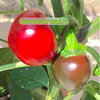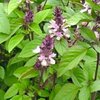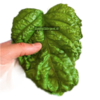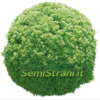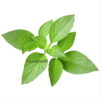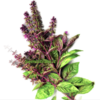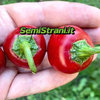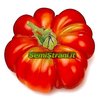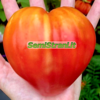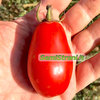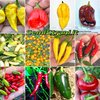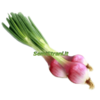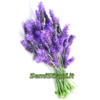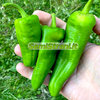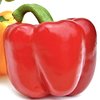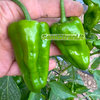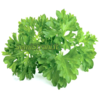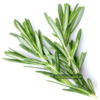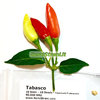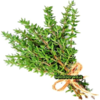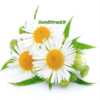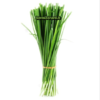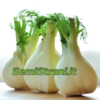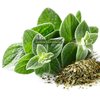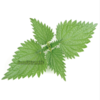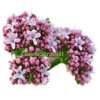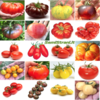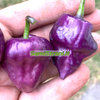12 CLASSIC AND HEALTHY AROMATIC HERBS SEEDS COLLECTION
Aromatic Herbs Seeds by Semi Strani by Carlo Martini
This is the Wonderful and super Healthy classic 12 Aromatic Herbs Seeds Collection, composed of the Seeds of the following varieties: GENOESE BASIL, SAGE, ROSEMARY, OREGANO, PARSLEY, THYME, CHIVES, WILD FENNEL, MINT, LAVENDER, CAMOMILE and VALERIAN.
The Cultivation of Aromatic Herbs is very simple, just like growing Basil. If planted in pots, remember to use a good universal soil to be mixed with pumice stone or expanded clay to allow for proper drainage, in the percentage of 80% soil and 20% pumice stone or expanded clay. Place the seeds about half a cm underground and moisten the earth with a light watering. The only really important thing is to respect the recommended sowing months if planted in the open field or on the terrace. If you plant the seeds keeping the pot at home you can do it practically all year round. The Seeds are shipped in comfortable tear-off plastic bags with a standardized Label and Seed Passport. Each envelope contains 10 Seeds for a total of 60 Seeds. None of these seeds are GMO. They are Seeds that I have personally produced in my small Individual Company "Semi Strani di Carlo Martini" which produces Rare and niche Seeds with "Tuscany Regional Authorization 6170 and RUOP IT-09-06170", therefore the Seeds are subjected to genetic checks to ensure the purity of what you buy. The seeds were produced during the last summer in Pistoia, so they are very fresh seeds and totally Made in Italy, you can sow them within two / three years by keeping them in the dark in a drawer in the original packaging, if instead you keep them in the fridge they will remain viable for more than 10 years.
Here is the description of what the 12 Aromatic Herbs Seed Collection contains:
- Genoese Basil (Ocimum Basilicum): the Italian Aromatic Herb par excellence: the classic Basil in the best variant, the one that comes directly from Genoa. Basil is used in the kitchen to flavor the tomato sauce of pasta and pizza, it is the main ingredient of Pesto Italiano and goes perfectly with tomato and mozzarella in Caprese Salad, but there are also many other possibilities and recipes to enhance its fragrant leaves. Basil is also considered a medicinal plant, with anti-inflammatory properties and beneficial properties against arthritis and bronchitis. On my site you can find numerous types of Basil, for me the best, in addition to the classic Genoese Basil, are the Giant Basil of Naples and the Greek Basil. It is planted from May to July in large but not deep pots such as planters with universal soil (90%) and pumice stone or expanded clay (10%), place the seeds about half a cm deep, water only once and keep it indoors. shade until the seedlings are born, which should happen within 4 - 6 days. A sachet contains +100 Seeds which will be more than enough to obtain numerous planters full of this delicious Aromatic Herb.
- Sage (Salvia Officinalis): a sachet contains 20-30 Seeds which will be more than enough to obtain many plants, in the end only one is enough, since it is a weed and it reproduces very easily by means of cuttings. It is the most loved aromatic herb in Italy after basil, it is used in the kitchen for many dishes, but do you know how butter and sage ravioli (Ravioli burro e salvia classic italian dish) taste cooked with sage planted directly by you? Simply exquisite! Sage has been known and used since the time of the Romans, who gave it a name which means "to save, health". Among the main effects it is an antiseptic, a digestive and a sedative. Being a weed, a single pot, or a single plant in the garden is enough to ensure this aromatic herb is fresh for almost the whole year. Plant it in spring around March, April, May in a small pot with Universal Soil and Expanded Clay placing a couple of seeds at a depth of one cm, after a couple of months it will be ready to be placed in its final home which can be a pot or directly on the ground, as an adult it will resist the winter.
- Rosemary (Rosmarinus Officinalis): together with Basil and Sage it is one of the main Aromatic Herbs, it has always been one of the most loved plants since ancient times as it is rich in therapeutic virtues and functions: it is an excellent tonic that exerts a stimulating action and fortifying in cases of inappetence and physical and mental fatigue; it is a valid pesticide, anti-inflammatory and antioxidant; boasts strong digestive properties and helps the liver in carrying out its functions; it is used as an ornamental plant to embellish gardens and flowerbeds; it is used to create perfumes and shampoos; burning the dry twigs away insects and mosquitoes; it is used to produce excellent honey. In the kitchen it is used to enrich many dishes with flavour, including meat, barbeque, fish, potatoes, focaccia and bread, it can be used to make an aromatic olive oil and blends of aromatic herbs. A plant in a pot or in the garden is more than enough to have fresh sprigs of Rosemary all year round, as it spreads becoming very large over the years. Sow using a pot with universal soil and pumice stone or expanded clay by placing two seeds per pot at a depth of half a cm, for this Aromatic Herb you need at least 20 degrees to germinate therefore plant in late spring by spraying a little water without overdo it, it will take 20 to 30 days to germinate. Much easier to make cuttings. A sachet contains 20 Seeds which will guarantee you many plants to put in pots or in the garden.
- Parsley (Petroselinum Crispum): Parsley is appreciated and known for its Aromatic and Therapeutic properties, it is used in the kitchen for hundreds of dishes. As the well-known saying goes, it goes well with all dishes, the leaves and stems are the parts used, both for fresh consumption and for the preparation of sauces, soups and fish. For example, it is used chopped to be added to salads or to the sauce for clams or vice versa with the whole leaves in roasted fish. It has a pungent and slightly bitter taste which brightens the flavor of other herbs. Parsley is rich in Vitamin A, B, C and K and mineral salts such as Potassium, Calcium and Iron; acts positively on liver functions helping the body purification; it is also rich in antioxidant substances; the poultice of pounded leaves is used to relieve mosquito bites; it has diuretic and sudorific properties, mainly due to a flavonic substance: apioside. In Chinese herbal medicine it is also used as a remedy for high blood pressure. Parsley fears frost, for this reason it must not be sown before mid-April and it continues to be planted until July, like many biennial plants, if the temperature drops below 10 degrees and it feels the arrival of a frost, the plant can pre flowering. The Seed takes 10 days to germinate, loves temperatures between 15 and 25 degrees. You can easily sow it in jars at home and then put it in the garden or always in a pot on the terrace or in the garden. The seeds must be buried less than a centimeter deep, after sowing a moderate rain watering is recommended. As always for the aromatic herbs, use universal soil mixed with pumice stone or expanded clay.
- Thyme (Thymus Vulgaris): Thyme is my favorite Aromatic Herb, its name derives from the Greek and whose meaning is "strength, courage", a quality that would awaken in those who smell its balsamic scent. It goes well with meats, fish, vegetables, mushrooms and aromatic vinegars. As happens with Oregano and Rosemary, the scent of Thyme after drying, instead of losing its aroma, gains it. It is considered useful against asthma, colds and headaches, it is also used as a natural remedy for tired skin and oily hair. It is very easy to grow, resists winter well and tolerates summer, to be placed in the sun. It is sown between the end of March and May in jars where you can put 3 or 4 seeds with Universal Soil and Pumice Stone, place the seeds not deep, under a sprinkling of soil, water little and keep in the shade, Germination will take place in 20 days about.
- Chives (Allium Schoenoprasum): it is a perennial plant of the Liliaceae family and forms thick bushes. The root is bulbous, while the leaves are long and thin, tubular in shape and of a bright green colour. It is an aromatic known for thousands of years, to be consumed fresh to garnish and enhance the taste of crepes, sauces, flavored butters, soups and sometimes fish dishes. Cultivating it is easy both in pots on the terrace and in the garden, as well as being an important plus in the kitchen it is also beautiful from an aesthetic point of view, in fact it gives us many sphere-shaped purple flowers that appear from the end of spring until summer . The leaves dry out during the winter but return to sprout in spring from the roots which are preserved during the vegetative rest, this is another good reason to cultivate chives: after having sown it the first year, we will have pots and flowerbeds that are always colorful and fragrant. Furthermore, like all onions, it has repellent properties against many parasitic insects. Chives can be sown outdoors from April to June in a sunny position. We can anticipate it in March, resorting to protected sowing in a seedbed to be protected in case or in a greenhouse. In both cases, the seeds should be placed at a depth of 1cm and a distance of 20cm. The harvesting of the stems lasts almost all year round, from February to December. The sachet contains about 100 Seeds which will be more than enough to obtain fresh chives all year round!
- Wild Fennel (Foeniculum Vulgare): is a Mediterranean herbaceous plant of the Apiaceae (Umbelliferae) family. Known since ancient times for its aromatic properties, its horticultural cultivation seems to date back to the 16th century. The wild fennel flower is harvested as soon as the flower is "open", normally from mid-August until late September. The fresh flower can be used or it can be dried outdoors and in the light, but away from direct sunlight which would evaporate the essential oils. Diachenes can be harvested at the beginning of autumn, when the transformation of the flower into fruit has taken place. The leaves and tender shoots can be picked from spring to late autumn. In phytotherapy the dried fruits or essential oil are used. Contains: Anethole from which its aroma depends, phencone, anisic ketone, dipinene, camphene, phellandrene, dipentene and methylcavic acid. The main use, as for plants like green anise and caraway, is carminative, that is, it helps to eliminate intestinal gas and at the same time prevents its formation. Therefore it is used for those with digestive difficulties, flatulence or aerophagia. You can eat the white heart of cultivated fennel, erroneously considered a bulb, raw in salads or boiled and au gratin and you can add it to stews. Wild fennel uses fresh or dried flowers, fruits or "diacheni", improperly called "seeds", leaves (or "beard") and twigs. The flowers are used to flavor boiled chestnuts, baked or pan-fried mushrooms, pickled olives and pork. Wild Fennel requires little care and is easily maintained and reproduced both in the garden and in a small vegetable garden. Here is the practical guide for growing it: being a rustic plant, it easily adapts to arid and difficult terrain, but can stand the cold. In regions where the ground freezes, its crops will not be found. You also need good exposure to the sun and shelter from too much wind. Requires well-drained soil. It also adapts easily to sandy and gravelly soils, but is more productive in soils with good organic matter. The right time for sowing is late spring and summer. The Seeds have a germinability rate ranging from 60% to 90%, they must be sown at a depth of one cm and once the seedlings have sprouted they must be placed at a distance of at least 30 cm from each other. They take from two to three weeks to germinate, if you plant them in pots use a pot with a diameter of about 15 cm, make the usual mix of universal soil and expanded clay and put two or three seeds per pot. To propagate the plant, just let the flower go to seed. A multitude of seeds are produced from a bush which are then very easy to germinate. It needs little water and also grows in arid areas. The entire bush can be consumed, right down to the base, so harvest every part of it. In particular, in autumn the roots, in summer the leaves and stems to be used as an aromatic herb and from the end of August to October the seeds, to spice dishes and make herbal teas. It fears aphids, if it is attacked you can cut the plant in the most infested parts, use nettle and garlic macerate. It also fears fungal diseases that start from the root and the soil, such as root rot and collar rot. To prevent the problem, pay attention to too much humidity and prevent any water stagnation. One sachet contains +100 Seeds which will be more than enough for a bountiful harvest.
- Mint (Mentha): is an exquisite perennial herbaceous plant and a natural tonic, considered a medical plant by the ancient Egyptians and Romans. It is an aromatic herb up to 70 cm tall, with erect stems and rhizomatous roots that spread considerably in the soil. The leaves are lanceolate and covered with a light, bright green hair. The flowers are gathered in terminal, conical colas, flowering from the bottom up. The single flowers, sympathetic and irregular, are small, white, pink or purple in colour; flowering occurs in the middle of summer and continues until autumn. Easy to grow, it prefers a little shady and humid area. The mint plant is easily attacked by parasitic fungi (Puccinia Menthae); its stems and leaves are filled with swellings and reddish dots which then evolve into blackish spots, the infected plants must be eliminated. It is also attacked by snails which are fond of it. Mint is harvested when the plant has fully flowered and taken to the appropriate distilleries, while for domestic use it is dried in a cool, airy place. Peppermint is particularly suitable for the preparation of cocktails and desserts. The sachet contains +300 Seeds which will be more than enough to make numerous, fragrant and summery Mint planters.
- Lavender (Lavandula Officinalis): it is a beautiful plant with very fragrant and relaxing lilac flowers. Do you think that according to a study by a Japanese University, smelling Lavender would bring a good mood. Lavender in Aromatherapy is used as an antidepressant, tranquilizer, balancing of the nervous system, as a decongestant for colds, to reduce blood pressure problems, digestive problems, back pain and ear pain, in short, a Pharmacy in a single plant. Lavender flowers retain their aroma for a long time even when dried, it is in fact customary to use them to perfume linen, make soap, make sachets with which to perfume the car and the wardrobe. Finally, it seems that it was used for the preparation of talismans and lucky charms linked to magical practices. The ideal time to sow Lavender is April but it can also be planted in May and June and in Autumn in October and November. The flowering of the plants occurs between June and July. It reaches the peak of its development 3 years after sowing. Use a pot of about 10 cm in diameter, fill it with soil and expanded clay and place 4 or 5 seeds at a depth of one cm, water a little and place everything on a window or terrace outside, consider that in general it is not easy to give birth to Lavender from the Seed, the germination times are even longer than a month and the Germinability is low around 50%. The sachet contains 50 seeds with which you can get numerous pots of this magnificent plant for the balcony or garden.
- Chamomile (Matricaria Chamomilla): it is a beautiful plant and aromatic herb with white and yellow flowers that boasts numerous uses in the homeopathic and culinary fields: it is an anti-inflammatory and a light sedative. It is used by making an infusion of flowers. Sowing can be done in the vegetable garden, in the garden or even in the pots you have on the balcony and must be done in the period from July to February, just throw the seeds in a fan shape on the earth and then put a sprinkling of soil on top, they will germinate in about 15 days, if you sow in a pot, use a planter after which you can put about twenty seeds. The sachet contains +300 Seeds which will be more than enough to make a few nice planters filled with Chamomile flowers.
- Valerian (Valeriana Officinalis): is a vigorous and perennial herbaceous plant of the Valerianaceae family. The term Valerian derives from the Latin and means "to be worth, to enjoy good health", in fact the use of this plant dates back to the times of the Greeks and the Latins, and still today, it is cultivated in many countries of the world for medicinal purposes, it is called also the "Natural Garden Calming". It grows spontaneously in humid and shady places, from the sea to the mountains, in central-northern Europe and northern Asia. It is also cultivated in European countries and in Japan. The flowering Valerian gives off a pleasant scent, which is particularly attractive for felines; from this characteristic derives the popular name of "cat grass". Valerian extracts and oil are used as flavorings in foods and beverages. Valerian is commonly used as a sedative in discomfort and sleep disorders, but also in states of agitation. For this purpose, it is often combined with hops, lemon balm or other herbs that promote sleepiness. A further medical application of valerian is in psychosomatic conditions related to anxiety and psychological stress. Valerian is a very cold-resistant aromatic herb: it can be sown until the end of November and then enjoyed in March at harvest time. It is in fact a plant that does not tolerate too hot temperatures and periods of drought. It is capable of growing even at a temperature of 15-20 degrees and is well suited to cultivation on the balcony: in case of excessive cold it will be sufficient to cover the seedlings with a cloth to ensure that they do not get damaged. Usually, the sowing of Valerian takes place in the autumn, broadcast or in rows about 15-20 cm apart. If you decide to grow them in pots, you can plant about ten seeds at a distance of about 5 cm from each other: as soon as the seedlings reach a height of 5 cm, they can be thinned out, keeping only the best ones. The cultivation of Valerian does not require much effort and, if done correctly, allows you to obtain a prolonged harvest: do not collect the whole plant, in fact it is enough to cut the leaves at the base so that it can develop others. The first leaves can be harvested about two to three months after sowing. It is important to ensure that the soil in which it is grown is well drained until the seedlings appear. Afterwards it is sufficient not to neglect irrigation, but to manage it sparingly. The sachet contains +100 Seeds which will be more than enough to obtain many Valerian plants!
Having said this, it goes without saying that it is a precious collection made up of hundreds of classic aromatic herb seeds obtained with years of passion and which will be appreciated by anyone who loves healthy foods and easy gardening, there is no need to being expert farmers to manage aromatic plants both in pots and in the garden, all you need is a little time and love for holy Nature.
You can find this Collection of Aromatic Herbs Seeds by Semi Strani / Weird Seeds in the various marketplaces throughout the web but only in My Shop you can find it at a discounted price.










































































